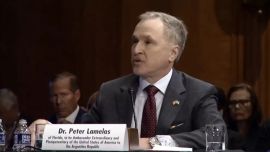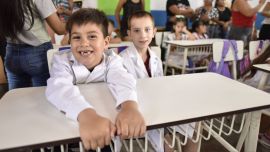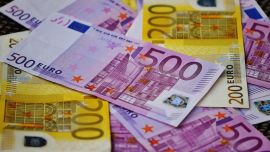Near midnight on January 18, 2015, the political climate started to become strained. The name Alberto Nisman – who had emerged from a week of high media interest given his denunciation against then-president Cristina Fernández de Kirchner over the Memorandum of Understanding with Iran, and that the following Monday he had to defend it in Congress, he was linked to a police event.
In the early hours, news channels started to cautiously reveal that something had happened in the flat of the then prosecutor of the AMIA Prosecution Unit. Then little-by-little, TV units and reporters started to gather by his building in Puerto Madero, as did the Police, the Coast Guard, court officials and even the then-Security secretary Sergio Berni.
“I can confirm that the death was with a gunshot. His mother found him," declared Berni.
At 4am that morning, after working for several hours, prosecutor Viviana Fein confirmed the news to the media: Nisman was dead.
Nine years have gone by since that fateful night, which marked a breaking point in Argentine politics. And even though it is a very wide window of time to investigate, the case has not yet been closed. The versions of what happened that day in one of the bathrooms of Nisman’s flat divide not just politicians, but much of society as well.
Did Nisman kill himself? Was Nisman murdered?
For the courts, the prosecutor’s death was murder. That position was made official by the Federal Court of Appeals in a 39-page opinion signed by Judges Martín Irurzun and Leopoldo Bruglia, in June 2018.
That was the case even though in an early report, the Criminal Investigation Forensic Medical Unit of the Argentine Federal Police concluded that it was a suicide.
Hours after he was found, at 10am, from the court morgue they communicated to prosecutor Fein that the result of the autopsy had concluded that there were no signs of his struggling or defending himself, “all of which leads to the conclusion that there were no third parties involved in the outcome of the death, and thus it could be a self-inflicted shot,” according to the case file.
According to the court, early on the investigation was almost exclusively heading in the direction of a suicide, when no hypothesis ought to have been ruled out, as suggested by Irurzun.
The judge himself, in his vote, stated: “The direct physical evidence – the position of the body when it was found, the haematic projection of both hands, the absence of chemical particles compatible with deflagration – and subsequent expert examinations – forensic, technological and psychiatric-psychological – and the testimonies of the activity developed by the victim moment prior to the fatal outcome, all provide evidentiary support that Natalio Alberto Nisman was murdered."
In his vote, Irurzun also pointed out that Nisman has security measures all around him: from those of the building complex where he lived to intelligence staff who monitored his activity and the custody of various security forces based on threats he had received in the past. He also mentioned that by December 2014 there were reports providing an account that the alert level on Nisman had increased.
Yet despite those barriers, the judge suggested that “the fact was planned and executed at a key moment of his occupation as a prosecutor without facing greater obstacles or triggering the least alert. It should be noted that, in its realisation, there should have been enough time to change the scene, not only regarding the victim’s body and surrounding elements, but also by tampering with the records of technological devices owned by him."
According to the magistrate, “there was a temporary blind spot that helped commit the crime.” Within that margin, “at least once person could have entered his flat, murdered him and flee – favoured by various and selective malfunctions in filming mechanisms – without triggering the least alert until the delayed find."
Generally speaking, the position was accompanied in his vote by Judge Bruglia.
As a basis, both took an expert report by the National Gendarmerie (Coast Guard), highly questioned in the case by Diego Lagomarsino’s defence and also by experts in the matter.
Among other matters, that study determined that “existing blood projections shown in photographs and videos match the dynamic leading to the ‘most likely hypothesis’ of the investigated event; that is, that Nisman’s death was violent and from a gunshot to the head by third parties, so far unidentified, who also attempted to simulate his suicide”.
Over five years have gone by since the Court of Appeal’s position became known, i.e. that it was a murdered committed by third parties.
During that whole time, and in the years prior to January 18, 2015, the courts have not been able to find evidence to locate the person who allegedly broke into Nisman’s flat and killed him.
For the defence, there is only one explanation. “It was a textbook suicide” said Lagomarsino, the IT technician who lent Nisman the .22 Bersa which fired the bullet that killed him. Lagomarsino is accused of being a direct participant of the murder, due to this fact.
He and all those defending the theory raise a central argument: that there is not a single piece of evidence which shows that there was someone else other than Nisman in the flat.
That being the case, the search for the murderer or murderers – based on the court’s hypothesis – has entered a stage of testimonies from many intelligence agents. That is where prosecutor Eduardo Taiano and Judge Julián Ercolini are looking for leads.
– TIMES/PERFIL




















Comments